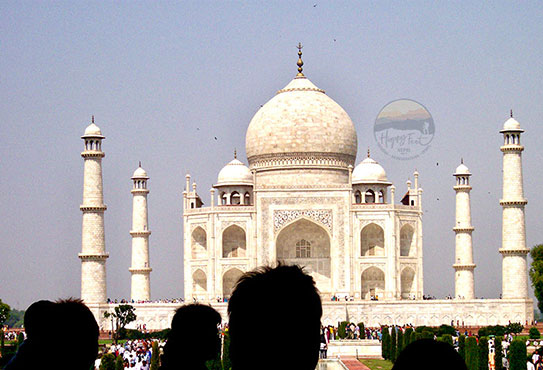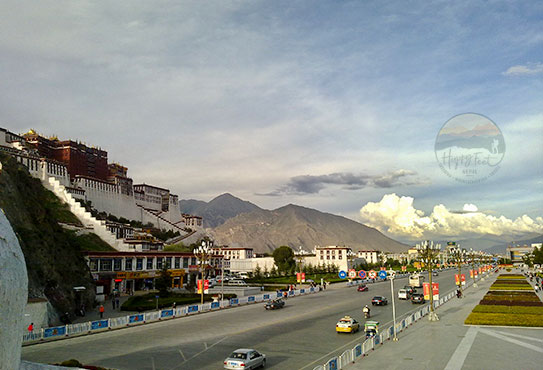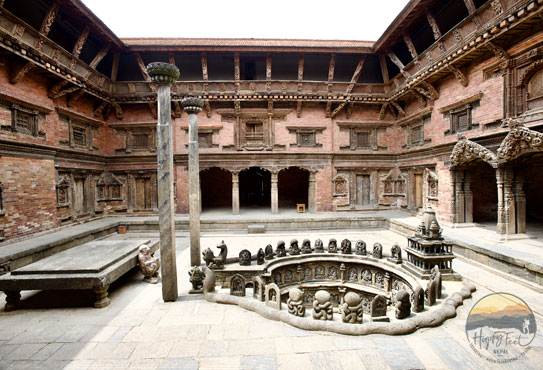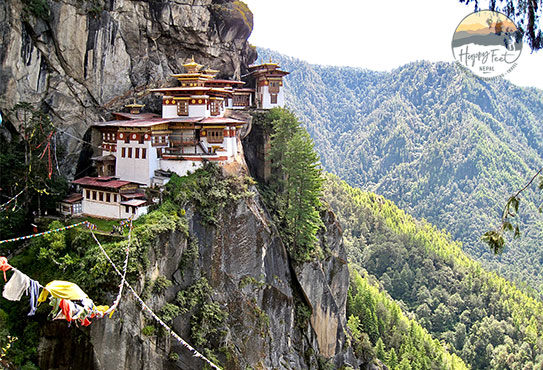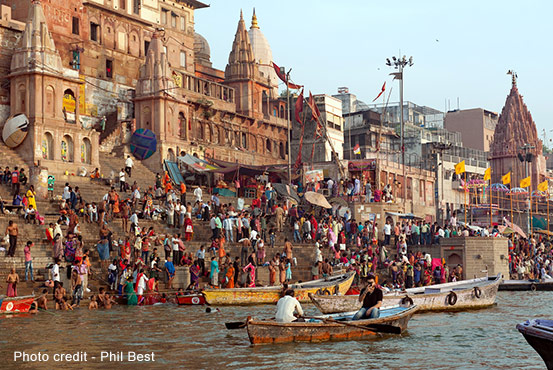Sunday - Friday: 9 AM - 4 PM
Power Places of Nepal and Tibet Tour 10 days
Join a Tibet Group Tour that departs each Saturday or take a Private Guided Tour, departing any day at your comfort
Enjoy our impeccably organized tours
Tour of Nepal visiting Kathmandu and the monuments surrounding the Kathmandu Valley, listed in the World Heritage Sites by UNESCO. Then we fly to Lhasa (Tibet), the land of the Gods, where we admire its impressive landscape and its massive monasteries, the power places of Tibetan Buddhism, in Lhasa, Tsedang, Samye and experience the Tibetan culture and life.
Our trip to Nepal and Tibet begins with the arrival flight to Kathmandu, the capital city of Nepal. Optionally, join a Tibet Group Tour that departs each Saturday or take a Private Guided Tour, departing any day at your comfort. In Kathmandu, we take relaxing sightseeing tours in its world-famous medieval villages, which have the largest collections of historical monuments and shrines ever built. These tour days are also essential to obtain the Tibet Visa, which takes three working days. This is the standard and fastest procedure for all nationals entering Tibet/China from Nepal.
Then we take a flight to Lhasa and spend a few days in Lhasa visiting the main sacred places such as the Jokhang Temple, the Potala Palace and some of the great monasteries such as Drepung and Sera. In Tibet we also visit Tibet’s first Capital the Tsedang, the Samye, the first monastery of Tibet and inaugurated by Guru Padmasambhava himself and the sacred sites of Chim-Puk and Hepo-Ri. If we write in only one sentence we provide you a genuine experience of local culture to make your trip worth recounting.
Arrive in Kathmandu, customs and immigration formalities and claim your baggage, which takes some time. Upon exiting, the arrivals get a traditional welcome from the Happy Feet Mountaineers representative and transfer to the hotel. Reach the hotel and the rest of the day is free with the possibility of optional excursions (not included), but you can ask to organize any of the tours or stroll through its vibrant streets.
Kathmandu, the capital and heart of the country, with three medieval cities, symbolizes Nepal’s everything. Having lived through the several ruling dynasties of Buddhists and Hindus, the culture and society of Kathmandu Valley have evolved through time to give it more than a unique feature. Today it is an urban city, and still rapidly increasing, that has its ancient myths and, at the same time, is testimony to the greatness of people who have lived there for time immemorial.
After breakfast, we’ll drive to Swayambhunath. Located on a lovely little hill, Swayambhunath Stupa is one of the fascinating architectural jewels of the country. This Buddhist shrine is said to have been built around 250 b.c. The white dome, the main feature of the Stupa, is identified with the spotless, pure jewel of Nirvana, and is crowned by a thirteen-tiered golden spire of conical shape. On the cube at the base of the spire is a pair of the Buddha’s all-seeing eyes, painted on all four sides. The Stupa stands on a typically stylized lotus mandala base, believed to have surfaced (self-originated) years ago from the lake that initially filled the Kathmandu Valley.
From the hilltop one can enjoy a panorama of Kathmandu and the rest of the Valley. A long stairway reaches the Stupa up the wooded hillside and past statues of the Buddha. But watch out for the monkeys! At the top, you’ll see devotees making rounds of the Stupa, spinning the praying wheels as they go around and around.
Other significant things to be seen here is a magnificent two-tiered golden temple of Harati, the grandmother deity of children and smallpox, believed to be an Ogress until later converted into Buddhist and to be a great caretaker of the children. Next to the temple is the Dewa Dharma Monastery, noted for a bronze icon of Buddha and traditional Tibetan paintings, destroyed by the 2015 earthquake and reconstructed.
The huge gold-plated Vajra, set on the Dharmadhatu mandala at the side of the Stupa, the priestly symbol of Vajrayana Buddhism, is worth a close look.
Then we’ll head on to Patan. Patan, located at a distance of 7-kilometres, was once an independent Buddhist city-state, and a rival of Kathmandu, from which it was separated by the Bagmati River. It is also called Lalitpur, literally the city of the Arts. The old centre has been designated a World Heritage Site by UNESCO.
Patan boasts a multitude of temples and wonders of art in and around its Durbar Square (Palace square). We’ll visit the Royal Palace, which occupies one side of the square, where works of art in every piece of wood, stone, and metal are in the exhibit in the open air. We also visit the temple of Krishna, the temple of Jagat Narayan, the Golden Temple and the Temple of Thousands Buddha, among other sites.
At around the end of the tour, we’ll also visit the Museum of Patan, located inside the medieval Palace, is a must for anyone interested in Asian Art, history of Nepal, curatorial science, or religion. It is a world-class museum that displays the traditional sacred art of Nepal in an illustrious architectural setting. Its home is an old residential part of Patan Durbar, one of the royal palaces of Malla kings of the Kathmandu Valley. The gilded door and window face one of the most beautiful squares in the country.
The museum also exhibits a long span of Nepal’s cultural history and some rare objects. Buddhism and Hinduism are explained in detail in extensive labels within the living traditions and context.
In the evening we’ll visit Basantapur, Kathmandu Durbar Square, the old palace complex exhibits the multitude of temples and palaces. The main attractions are the Gaddi Baithak Durbar, a Palace constructed in the Rana style in 1908, Basantapur Durbar, the main building of the old Royal Palace, Kumari Chowk, the residence of the Living Goddess and Kumari Bahal, where the family of Kumari resides.
Some two hundred years ago, a Western visitor wrote that there were as many temples as there were houses and as many idols as there were people, in the city. Indeed, Kathmandu boasts one of the largest assemblages of magnificent historical monuments and shrines ever built. Duly recognized as a World Heritage Site by UNESCO, Kathmandu Durbar Square lies in the heart of the city. Locally, it is also called Hanuman Dhoka Palace Square. The fascinating part of this Palace complex is the towering Nine Storey Palace, overlooking the beautiful cityscape and the vast Basantapur Square. In 1768 A.D., King Prithivi Narayan Shah built a mansion to commemorate his conquest of the Valley is known for intricately carved wooden doors, roof struts and massive lattice windows full of mythical figures.
Finalize the tour and exit through Ason Bazaar, an old city centre and market, where one can see and experience a bit of what the Nepalese use in their daily life. The walk takes us until the hotel.
After breakfast we’ll set off to Pashupatinath temple, considered one of the holiest of Hindu shrines. Pashupati has remained the presiding deity of all Hindu Nepalese royalty. The precinct occupies an area of 281 hectares. The main temple, displaying a golden tiled roof, is off-limits to non-Hindus. To view the main temple and one of its few main gates you’ll have to cross the river and climb steps to the terrace lying opposite. Along the way, you may come across Hindu sadhus and Santas there on a pilgrimage. These ghats (cremation group) along the Bagmati River are where the bodies of recently deceased Hindus of the Valley are cremated.
The trip takes us on to Bhaktapur. Bhaktapur, located about 15-kilometres east of Kathmandu, is the third major city of the Valley. Bhaktapur or Bhadgaon, literally “the City of Devotees”, is truly a living museum. There is the 55-windowed Royal Palace, the temple of Taleju, the Palace of the Kumari, the temple of Pasupati, the main square of Taumadhi Tole, Nyatapola (the temple of the Five Pagoda Roofs, the tallest such in all of Nepal), the temple of Akash Bhairab (the second most important temple of Bhadgaon). We will also visit the square of Dha Hateya and the Square of the Potters. UNESCO recognizes Bhaktapur as a World Heritage Site. Finalize the tour and drive back to Kathmandu.
Transfer to the airport for the flight from Kathmandu to Lhasa on China Southwest Airlines. This one-hour trans-Himalayan flight will allow you to have an aerial view of the Mt. Everest and other Himalayan peaks. We’ll arrive at Gonggar airport at around 1.30 p.m., local time. After clearing immigration and customs, it will be a one hour drive to cover the 90 Kilometres to Lhasa. Arrive at Lhasa and check into your hotel. The rest of the time is to
Lhasa, the capital of the Tibet Autonomous Region, is located between 290 36’N and 190 06’E at the north bank of Kyichu river, a tributary of the Yarlung Tsangpo river, at an altitude of 3650 meters above the sea level. The Lhasa has a history of more than 1300 years and has been the centre of politics, economy, culture, and religion in Tibet since ancient times. “Lhasa” in Tibetan means “the land of Gods”. In Lhasa, there is a plentiful of scenic spots and historical attractions, among which Potala Palace, a thirteen-story, 1000 room Palace of the Dalai Lama, Norbulingka, the summer Palace of the Dalai Lama, Drepung Monastery, Sera Monastery, Jokhang Temple, the holiest shrine of Tibet, and the famous Ramoche temple.
Breakfast and pay a visit to the Jokhang Temple, situated in the centre of the old section of Lhasa called Barkhor, was built in the mid-7thcentury AD. It was extended later by successive rulers and has now become a gigantic architecture complex. Located in the east, and facing the west, Jokhang is a four-storeyed temple with splendid golden roofs. Its architecture features art from the Tang Dynasty but also assimilated many features from both Nepalese and Indian Buddhist temples. The murals in the temple depict the life stories of historical and religious characters. The temple houses many ancient relics, including statues of King Shrongtsen Gompo, Princess Wencheng, Princess Brikuti Devi (Nepalese). Princess willow (a tree), and the uncle–Nephew Alliance Tablet. Jokhang is Tibet’s spiritual centre and the holiest destination for Tibetan Buddhist pilgrims. It contained a sitting statue of Shakyamuni when he was 12 years old.
We then continue to Potala Palace, one of the most famous architectural works of the Tibetan World, which sits on top of the red hills in Lhasa. It was built in the 7th century after the Tibetan King Shrongtsen Gampo married Princess Wencheng of the Tang court. The Palace was built to provide a court with a place of worship and meditation. In the mid 17th century, it was rebuilt by the 5th Dalai Lama to its present size and became the winter Palace of the Dalai Lamas. The construction took fifty years from beginning to completion.
The Potala Palace is divided into two sections, namely, the red Palace and White Palace. The total height of the Potala is 117 meters spanning thirteen stories. The length of the Palace from east to west is 400 meters, and the breadth from south to north is 350 meters. The building was constructed with stone and timber with golden roofs. It is a majestic architectural masterpiece.
In the evening we visit Barkhor Street, the holiest pilgrimage site in Lhasa, with innumerable shops, and wayside peddlers intermingle with devotees walking clockwise around the Jokhang. There are four huge prayer flags in each corner of Bhakor square, known respectively as Gadhen Dharchen in the northeast, Juyak Dharchen in the west, Kelsang Dharchen in the southwest and Shar Kyaring Dharchen in the southeast. An evening walk (Kora) around the Jokhang Temple, together with the Tibetan pilgrims is a lifetime experience.
Today we will visit the Drepung Monastery, situated on the slope of Wuze Hill, five kilometres northwest of Lhasa. It was built in 1416 and is the largest of the monasteries of the Gelugpa sect. It covers an area of 250,000 square meters. In its heyday, it had more than 10,000 monks.
Finalize the visit to the Drepung and proceed to the Norbulingka, the summer palace of the Dalai Lama and currently a museum.
At around 14:00 hours visit the Sera Monastery located about 3km north of Lhasa and at the foot of Tatipu Hill. Sera is one of the most important monasteries and sacred to the Gelugpa sect, founded by Tsong Khapa or yellow hat sect, a branch of Tibetan Buddhism, in 1419, once had 7,000 monks. It has several buildings, the main ones being the Salón Coquen and the specialized schools. Inside the monastery there are preserved sacred scriptures written with gold dust, murals and unique statues, with main statue of Hayagriva, the Horse-headed (protector of the Dharma). This monastery is famous for the monk’s debate for a few hours each afternoon. There is a question-and-answer session during this ritual where a senior monk asks a junior with grimaces, applause, and feigned threats. The important part of this ritual must go through the knowledge of the theosophical questions of the Tibetan lamaistic Buddhist. A very curious moment for the tourist.
After breakfast, depart by road to Tsetang about 160km south-west of Lhasa. Arrive and transfer to the hotel. Tsetang is located on the southern bank of the Yarlung Tsangpo River, at an elevation of 3,600m, and is known for its grazing lands, beautiful river valleys, snow-capped mountains and glaciers. It has a rich variety of flora, distributed vertically according to elevation. Highlights in Tsetang include the first Palace of Tibet, its first monastery, the first Buddhist Hall, and the Tibetan kings’ tombs.
After refreshment and lunch, we start the tour with Yumbu Lhakhang, the first palace in Tibetan history, built in the 2nd century, on top of a hill. In the palace are the statues of three periods of Buddha. We further continue and visit the Tradruk Temple, a monastery established by King Songtsen Gampo in the 7th-century and belonging to the Gelugpa sect. The ancient images preserved here are made of bronze, and the corridors are full of murals. Finally, visit several Tombs of Ancient Kings; eight or nine tombs are still in good condition. The rest of the day is free on your own.
Departure to the Samye Monastery, located on the northern shore of the Yarlung Tsangpo River. It is a 50 kilometers drive. Reaching Samye you will check into your hotel and leave for the sacred Chim-Puk tour. Chim-Puk is a sacred cave site where Guru Rinpoche, also known as Padmasambhava, meditated and attained enlightenment. Inside the cave are several small chambers, each containing a statue or a mural of a different Buddhist deity. Visitors to the cave pass dozens of sacred caves and enjoy its serene atmosphere, which makes it an ideal place for meditation and contemplation. The tantric practitioners of Chim-Puk were once famed for protecting fields from hailstorms. Those having an extra day at Samye can reach the summit of Chim-Puk and enjoy a broader view of Yarlung Tsangpo Valley, a whole-day trip.
Back to the Hotel and in the afternoon visit the Samye Monastery, considered the first monastery in Tibet, was built in 779 under the supervision of Guru Rinpoche and the Tibetan King Trisong Detsen. The magnificent and unique central hall is three stories high. The first floor is in the Tibetan style, the second in the Han style, and the third in Nepal style. The halls of the monastery contain many statues and murals. The monastery has bronze bells, lions and carved marble tablets that record the development of Buddhism in Tibet. It attracts thousands of visitors each year who come to pay their respects to the Buddha and to learn more about Tibetan Buddhism.
Early morning, before breakfast, hike to Hepo Ri. Hepo Ri is a mountain 400m east of the Samye Monastery, and it requires a 30-minute hike. The locals consider it sacred and a popular pilgrimage site for Buddhists. Many important deities and spiritual beings are believed to reside there, and pilgrimage to the mountain can bring great spiritual benefits. The trail leads from Samye’s East Gate, and a side ridge climbs to an incense burner point with prayer flags, with fantastic views of Samye below. Hepo ri is also said to be where Guru Padmasambhava conquered the demons that disturbed the founding of the Samye Monastery. King Trisong Detsen established a palace here. Hepo Ri is among Tibet’s four sacred hills: ChagpoRi in Lhasa, Gangpo Ri at Tsetang, and Chuwo Ri at Chushul. King Trisong Detsen established a palace here. Trails branch off here from the road leading from Samye’s East Gate. From Hepo Ri, descend south along a paved path and enjoy great views.
Back to the hotel, breakfast and drive to Gonggar airport to board the flight to Kathmandu. Arrive and transfer to the hotel. The rest of the day remains at leisure in Kathmandu.
Breakfast and the rest of the day are leisure on your own. The Representative of Happy Feet Mountaineers will arrive at your hotel with transport three hours before your departure flight time. Get escorted from the hotel to the International Departure Terminal, see off formalities, and go through the immigration and departure.
